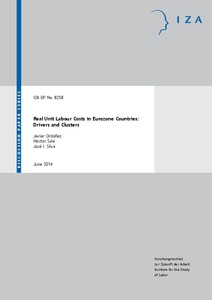Real unit labour costs in Eurozone countries: drivers and clusters
"We examine the trajectories of the real unit labour costs (RULCs) in a selection of Eurozone economies. Strong asymmetries in the convergence process of the RULCs and its components – real wages, capital intensity, and technology – are uncovered through decomposition and cluster analyses. In t...
| Main Authors: | , , |
|---|---|
| Institution: | ETUI-European Trade Union Institute |
| Format: | TEXT |
| Language: | English |
| Published: |
Bonn
2014
IZA |
| Subjects: | |
| Online Access: | https://www.labourline.org/KENTIKA-19118087124919362699-Real-unit-labour-costs-in-euro.htm |
| Summary: | "We examine the trajectories of the real unit labour costs (RULCs) in a selection of Eurozone economies. Strong asymmetries in the convergence process of the RULCs and its components – real wages, capital intensity, and technology – are uncovered through decomposition and cluster analyses. In the last three decades, the PIIGS (Portugal, Ireland, Italy, Greece, and Spain) succeeded in reducing their RULCs by more than their northern partners. With the exception of Ireland, however, technological progress was weak; it was through capital intensification that periphery economies gained efficiency and competitiveness. Cluster heterogeneity, and lack of robustness in cluster composition, is a reflection of the difficulties in achieving real convergence and, by extension, nominal convergence. We conclude by outlining technology as the key convergence factor, and call for a renewed attention to real convergence indicators to strengthen the process of European integration." |
|---|---|
| Physical Description: | 35 p. Digital |

